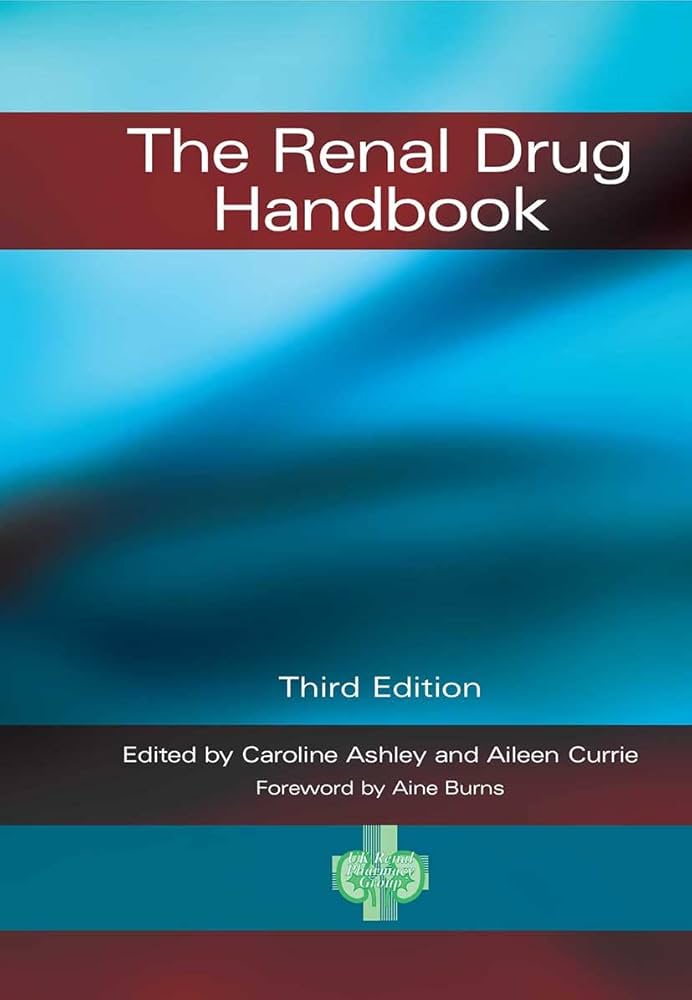When it comes to drug therapy in patients with kidney disease, precision is paramount. The renal system plays a crucial role in filtering waste and medications from the body, and compromised kidney function can alter how drugs are metabolized. One indispensable tool in managing medication safety for these patients is The Renal Drug Handbook. This comprehensive reference guide is an essential resource for healthcare professionals who need to make informed decisions on drug dosing in patients with renal impairment.
What is The Renal Drug Handbook?
The Renal Drug Handbook provides detailed information on the use of drugs in patients with kidney disease. Published by CPT Press, the book has grown to become a trusted reference guide worldwide. The latest edition includes over 800 drug monographs and is tailored to help clinicians adjust medications for patients with various levels of renal impairment or those on dialysis.
This invaluable handbook covers:
- Drug pharmacokinetics (how drugs are absorbed, distributed, metabolized, and excreted)
- Recommendations for dose adjustments in patients with renal impairment
- Advice for patients on different types of dialysis, including hemodialysis and peritoneal dialysis
- Drug interactions and contraindications in renal patients
The scope of the guide is broad, addressing everything from over-the-counter medications to specialized treatments for chronic kidney disease (CKD) and dialysis-dependent patients.
Why is Adjusting Medication for Kidney Disease Important?
The kidneys are responsible for filtering and excreting many drugs and their metabolites from the body. In patients with impaired kidney function, this filtering process slows down, leading to the accumulation of drugs or their toxic metabolites, which can result in severe side effects or toxicity.
For instance, common medications like antibiotics, pain relievers, and even certain blood pressure drugs must be carefully adjusted in patients with reduced kidney function. Incorrect dosing can lead to adverse effects, including:
– Drug toxicity: Accumulation of drugs like NSAIDs, opioids, or certain antibiotics can cause significant harm.
– Subtherapeutic effects: Some drugs require higher doses in renal failure to achieve therapeutic levels, such as certain antifungal agents.
This is where The Renal Drug Handbook plays a critical role. It offers clear guidelines for adjusting drug regimens, ensuring patient safety, and optimizing therapeutic outcomes.
Key Features of The Renal Drug Handbook
1. **User-Friendly Layout**:
The handbook is designed for easy navigation, allowing healthcare professionals to quickly access the information they need. Each drug monograph is presented in a clear format with recommendations for different stages of renal function.
2. **Comprehensive Content**:
The book covers a wide range of medications, including less commonly prescribed drugs, herbal supplements, and drugs used specifically for renal conditions.
3. **Updated Information**:
The latest edition includes updated information reflecting the most recent clinical research. As drug therapies evolve, so do the guidelines, and The Renal Drug Handbook keeps pace with these changes.
4. **Dose Adjustments for Dialysis Patients**:
This feature is particularly useful for nephrologists and pharmacists, as it outlines the necessary changes in drug dosing for patients undergoing various forms of dialysis, including continuous renal replacement therapy (CRRT).
How The Renal Drug Handbook Improves Patient Safety
Using this guide, healthcare providers can tailor drug regimens to each patient’s kidney function, reducing the risk of drug toxicity and ensuring efficacy. It is especially critical in managing chronic kidney disease (CKD) patients, who often have multiple comorbidities that require polypharmacy.
Some examples of drugs requiring adjustments in renal impairment include:
– Antibiotics: Drugs such as vancomycin and gentamicin require close monitoring and dose adjustments to avoid nephrotoxicity.
– Anticoagulants: Warfarin and newer oral anticoagulants (NOACs) may require dose modification due to altered metabolism in renal impairment.
– Antihypertensives: ACE inhibitors and ARBs may need careful dosing or avoidance in severe renal impairment.
Who Should Use The Renal Drug Handbook?
The handbook is designed for a wide range of healthcare professionals, including:
– Nephrologists: Specialized kidney doctors who deal with CKD, acute kidney injury (AKI), and dialysis patients.
– Pharmacists: Both hospital and community pharmacists who need to dispense medications safely to renal patients.
– Nurses: Especially those working in dialysis units, where drug dosing adjustments are common.
– General Practitioners: Family doctors often encounter CKD patients and need to be aware of the necessary drug adjustments.
Where to Get The Renal Drug Handbook?
The latest edition of The Renal Drug Handbook is available from various online medical bookstores and can also be accessed through institutional licenses. For clinicians who require up-to-date renal drug information, purchasing the handbook from trusted sources is crucial.
Check out the following reputable sources for your copy:
– CPT Press (Official Publisher)
– Amazon
– Wiley Online Library
Conclusion
The Renal Drug Handbook is an indispensable resource for clinicians managing patients with kidney disease. With the prevalence of CKD rising globally, the ability to accurately adjust medications based on renal function is more important than ever. This handbook serves as a critical guide to improving patient outcomes, minimizing adverse drug reactions, and ensuring safe prescribing in this vulnerable population.
https://amzn.to/4eaKkny
Looking for more insights on managing medications in renal patients? Explore our blog on the Top 5 Considerations for Drug Prescribing in CKD.
Discover more from Beauty Cosmetics
Subscribe to get the latest posts sent to your email.

